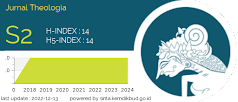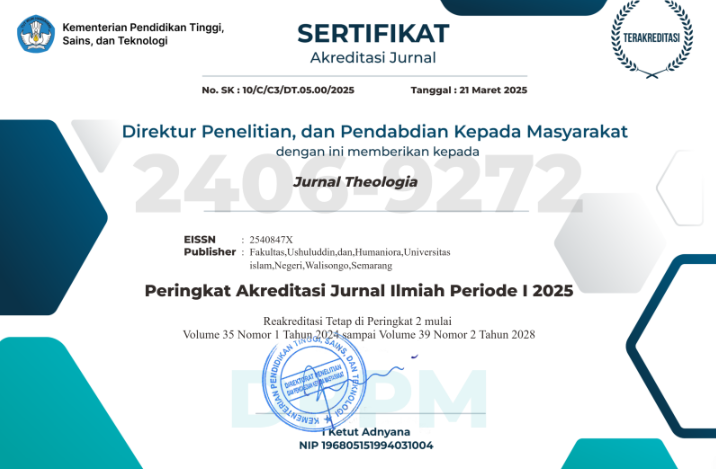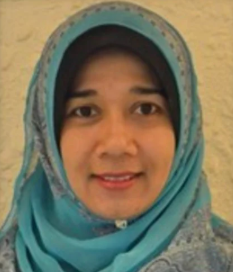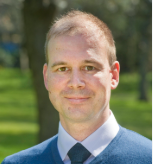Film Islami Sebagai Model Interpretasi atas Al-Qur'an dan Hadis: Kasus Film Ayat Tentang Cinta
DOI:
https://doi.org/10.21580/teo.2020.31.1.5621Keywords:
Film Islami, Ayat Cinta, Living al-Qur’an, Semiotika, Charles Sander Pierce.Abstract
This paper analyzes the movie Ayat tentang Cinta, which still has not received much attention from the researchers, namely from the aspect of the existence of the Qur'anic verses and traditions in it. Two core questions want to be the focus of the study, first, how does the movie Ayat tentang Cinta position the Qur'an [and hadith] as a representation of an interpretation of the Qur'an and hadith? Secondly, how is the existence of the values of the Qur'an [and hadith] in the film being one of the concourses of righteousness? This paper is a qualitative study, using content analysis and a semiotic approach. The results of this study show that in the movie Ayat tentang Cinta, it appears how the scenes displayed by the actors can show the relevant point of a movie as an interpretation of the Qur'an and Hadith, for example, the cafeteria in marriage is allegedly based on the QS. Al-Nur: 26. Secondly, in the movie Ayat tentang Cinta, many of the values of the Qur'an and Hadith in its diverse form, such as how each central figure in the movie describes the things that are relevant to the values of the Qur'an and hadith, at least through the distinctive scenes. All of this, as well as being one of the interesting facts about the construction efforts of righteousness by actors into the minds of audiences. Of course, in typical terminology.
Downloads
References
Ahmad Toni dan Rafki Fachrizal, “Studi Semitoka Pierce pada Film Dokumenter ‘The Look of Silence: Senyap’”, Jurnal Komunikasi, Vol.1, No.2 (2017): 137-154.
Alga Lilis Kusuma Dewi, dkk, “Analisis Semiotika Film Christian Metz: Studi Kasus Visualisasi Pesan Religi dalam Film Hijrah Cinta”, Publika Budaya, Vol.5, No.1 (2017): 21-27
Syaiful Qadar Basri, “Film 99 Cahaya Di Langit Eropa Yang Merepresentasikan Film As Social Practice Bagi Wanita Muslimah”, Jurnal LP3M, Vol.4, No.2 (2018): 122-131
Zahrotus Sa’idah, “Konstruksi Kesalehan dalam Film Cinta Suci Zahrana (Antara Identitas, Modernitas dan Komodifikasi Agama)”, Tesis (2017): 1-112.
Jalaluddin dan Nabilla Putri Syarifa, “Represenasi Citra Positif Islam dalam Film Kingdom of Heaven”, Jurnal Studi Islam, Vol.15, No.1 (2019): 58-74.
Hosen, Nadirsyah. Tafsir al-Qur’an di Medsos. Yogyakarta: Bentang Pustaka, 2017.
Wahjuwibowo, Indawan Seto. Semiotika Komunikasi Edisi III: Aplikasi Praktis Untuk Penelitian dan Skripsi Komunikasi. Tangerang: Rumah Pintar Komunikasi, 2019.
Yayan Rahtikawati, Dadan Rusmana. Metodologi Tafsir Al-Qur’an. Bandung: Pustaka Setia, 2013.
Jalaluddin al-Mahalli, Jalaluddin as-Suyuthi, Tafsir Jalalain; Lengkap dan Disertai Asbabun Nuzul, (Jakarta Timur: Al-Kautsar, 2017), hlm.219.
M. Quraish Shihab, Tafsir Al-Misbah: Pesan, Kesan dan Keserasian al-Qur’an, Vol. 8, (Jakarta: Lentera Hati, 2002.
Syarifah Gustiawati, Novia Lestari, “Aktualisasi Konsep Kafa’ah Dalam Membangun Keharmonisan Rumah Tangga”, Mizan: Jurnal Ilmu Syariah, Vol. 4, No. 1 (2016).
Aimie Sulaiman, “Memahami Teori Konstruksi Sosial Peter E. Berger”, Jurnal Society, Vol. 6, No. 1 (2016).
Nurbayati, Husnan Nurjuman, Sri Mustika, “Konstruksi Media Tentang Aspek Kemanusiaan Pada Poligami (Analisis Isi Terhadap Film Surga Yang Tak Dirindukan), Jurnal Riset Komunikasi, Vol. 8, No. 2 (2019).
Ubaidillah, Ening Herniti, Aning Ayu Kususmawati, “Penitraan Perempuan Islami dalam Iklan Komersial: Analisis Semiotika”, Musawa, Vol. 16, No. 1 (2017).
Nurul Afifah, “Pakaian Syar’i, Media dan Konstruksi Kesalehan Perempuan”, Sosiologi Reflektif, Vol. 13, No. 1.
Moh. Zahid, “Posisi dan Fungsi Mushhaf Al-Qur’an dalam Komunikasi Massa”, Nuansa, Vol. 11, No. 1 (2014).
Tika Kurnia Nurazizah, Saeful Anwar, Bahruddin, “Pesan Dakwah Pada Media Sosial”, Tabligh: Jurnal Komunikasi dan Penyiaran Islam, Vol. 3, No. 3 (2018).





















